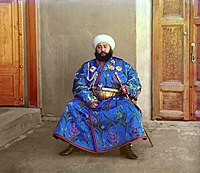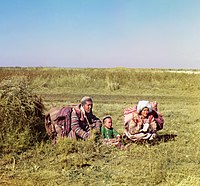Khalat

A khalat is a loose long-sleeved outer silk or cotton robe common in Central Asia, Iran, Pakistan and northern India and worn both by men and women, although in differing styles.
The Arabic word "khilat" means "dress" from khil, "to have". [citation needed]
Historically, richly adorned khalats have been used as honorific awards, similarly to mantle. The word khalat/khilat was also used to denote the ceremony of awarding the honorific robe. Such social aspects of clothing have been known in many societies. By the 19th century in British India the word khillat had come to mean any gift of money or goods awarded by the Government of India in return for service from tributary princes, khans and tribal leaders.
Central Asian khalats can be a thin, decorative garment, or thick, full length robe, a good protection both from daytime/summer heat and night/winter cold.
The word khalat is one of many borrowings to be found in Russian, where it has come to be a generic term for various robes, and in Romanian (the Romanian word is "halat"): dressing gown, bathrobe, smock (e.g., doctor's smock, patient's smock), camouflage cloak, etc.

See also
References
- Stewart Gordon, "Robes of Honour: Khilat in Pre-Colonial and Colonial India". Oxford University Press, 2003, ISBN 0-19-566322-5
